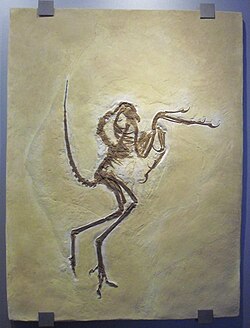| Wellnhoferia Temporal range: Late Jurassic, | |
|---|---|
 | |
| The type specimen | |
| Scientific classification | |
| Kingdom: | Animalia |
| Phylum: | Chordata |
| Class: | Reptilia |
| Clade: | Dinosauria |
| Clade: | Saurischia |
| Clade: | Theropoda |
| Family: | † Archaeopterygidae |
| Genus: | † Wellnhoferia Elżanowski, 2001 |
| Type species | |
| †Wellnhoferia grandis Elżanowski, 2001 | |
Wellnhoferia (named after Peter Wellnhofer) is a genus of early prehistoric bird-like theropod dinosaur closely related to Archaeopteryx . It is known from a single species, W. grandis, that lived in what is now Germany, during the Late Jurassic. While Wellnhoferia was similar to Archaeopteryx, it had a shorter tail and its fourth toe was shorter than that of Archaeopteryx. Andrzej Elżanowski (2001) of the Institute of Zoology of the University of Wrocław, Poland, determined the differences resulted from a "phylogenetic reduction rather than individual variation." [1]










